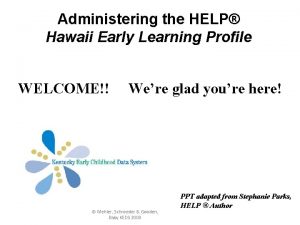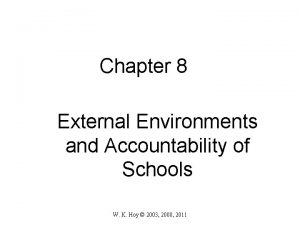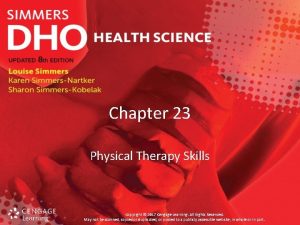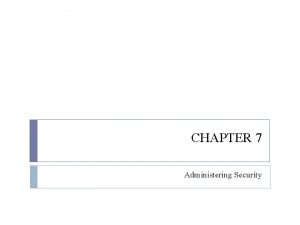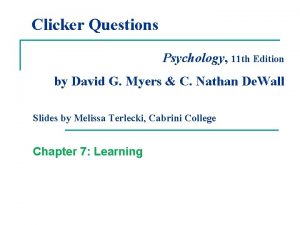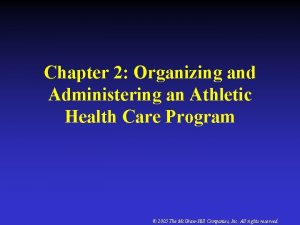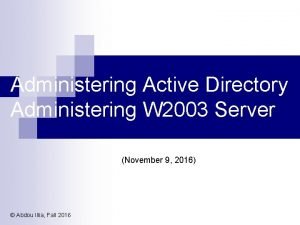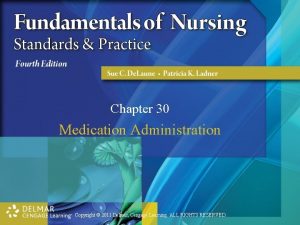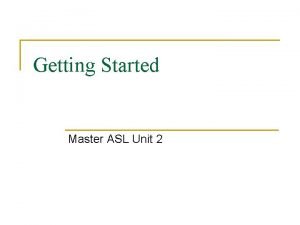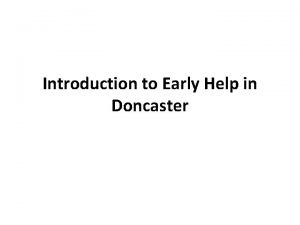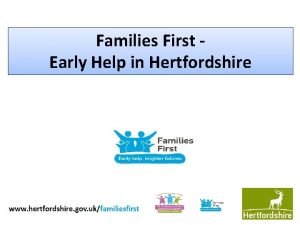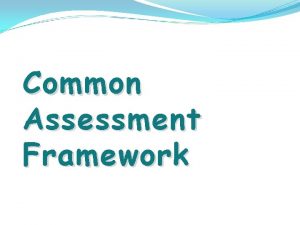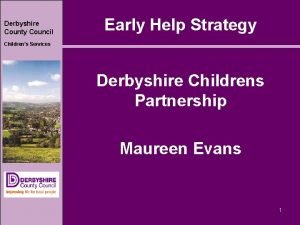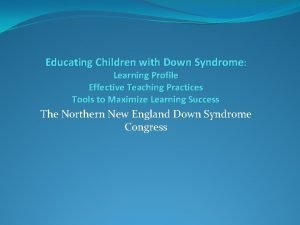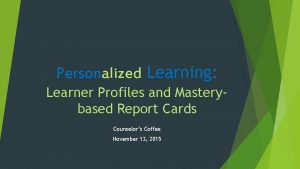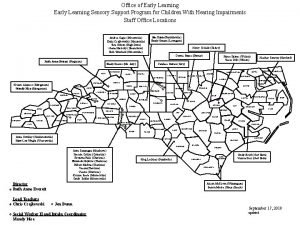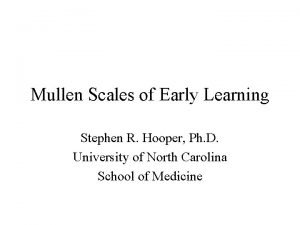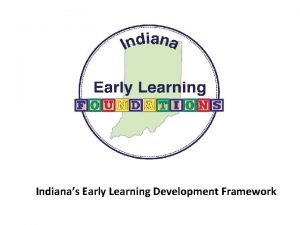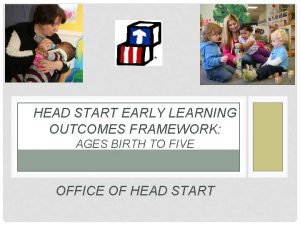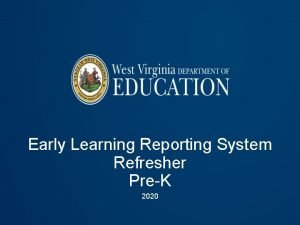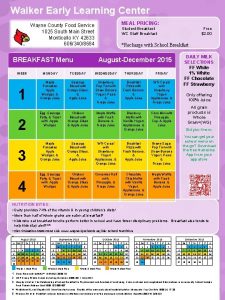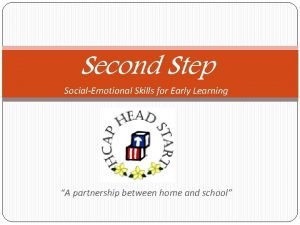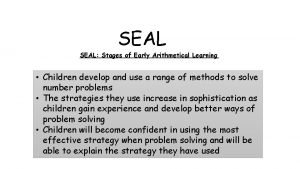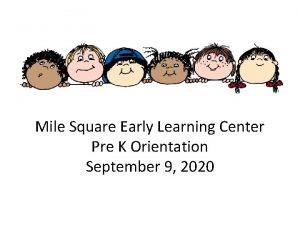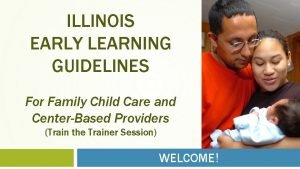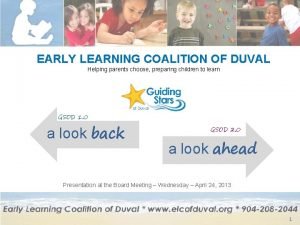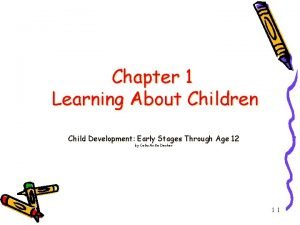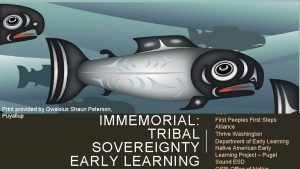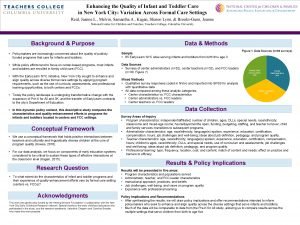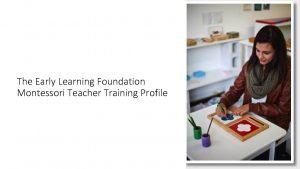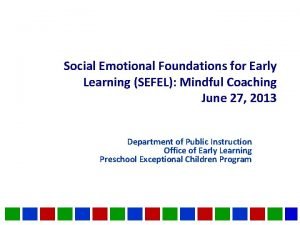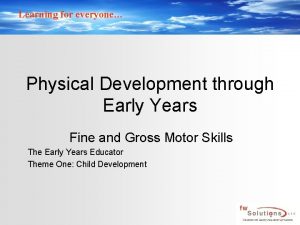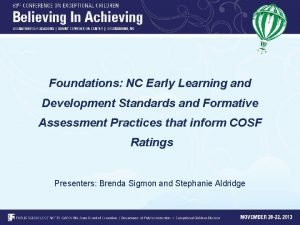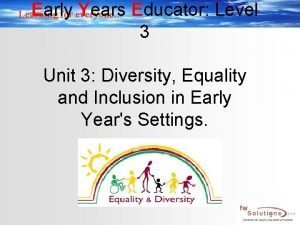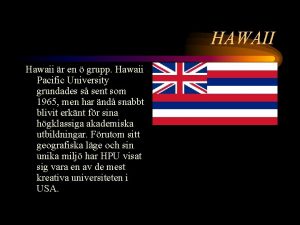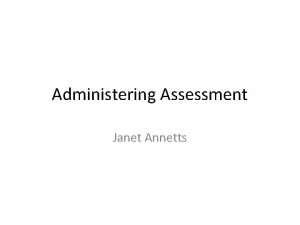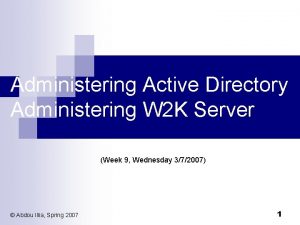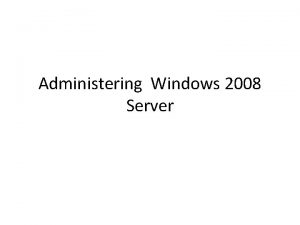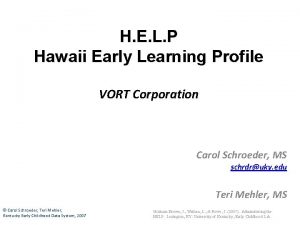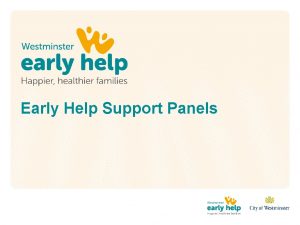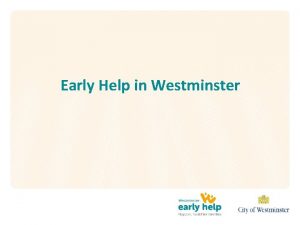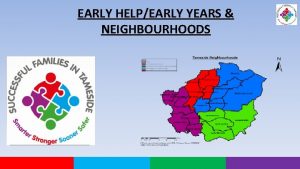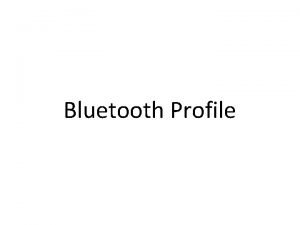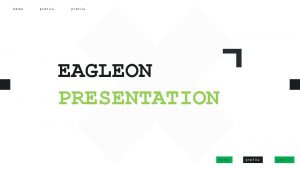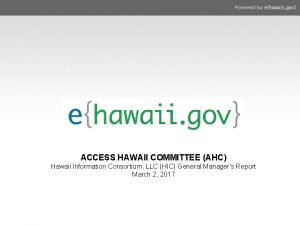Administering the HELP Hawaii Early Learning Profile WELCOME










































































- Slides: 74

Administering the HELP® Hawaii Early Learning Profile WELCOME!! We’re glad you’re here! © Mehler, Schroeder & Gooden, Baby KEDS 2008 PPT adapted from Stephanie Parks, HELP ® Author

Housekeeping • • Make yourselves comfortable Learn by doing Table supplies & Numbers Comfort station Parking lot Lunch & Breaks Ground rules © Mehler, Schroeder & Gooden, Baby KEDS 2008

Let’s Get Acquainted 1. Note room locations #1, #2, #3, #4. 2. Read series of statements/questions on screen. 3. Go to the Room # of the statement that best reflects you. 4. In your small group, follow directions on overhead. • If group is over 4, subdivide. 5. Goal: meet several new people. © Mehler, Schroeder & Gooden, Baby KEDS 2008

My profession is. . . 1. 2. 3. 4. Developmental interventionist OT or PT SLP Other Introduce yourself and tell one thing you like about your job. © Mehler, Schroeder & Gooden, Baby KEDS 2008

I have worked in the First Steps system for. . . 1. 2. 3. 4. Less than one year One to two years Three to five years More than five years Intoduce yourself and tell what is most rewarding about your work in First Steps. © Mehler, Schroeder & Gooden, Baby KEDS 2008

I. . . 1. Have heard of the HELP, but know almost nothing about it. 2. Know a little about the HELP, but have not administered it. 3. Have administered the HELP a few times. 4. Am very knowledgeable about the HELP and have used it extensively. Introduce yourself and tell one thing you know about the HELP. © Mehler, Schroeder & Gooden, Baby KEDS 2008

Agenda for Administering the HELP® • Overview of HELP® components • Hands-on exploration of Inside HELP and HELP Strands • Practice item crediting using video clip • Practice determining approximate developmental age levels for HELP® Strands • Summary © Mehler, Schroeder & Gooden, Baby KEDS 2008

Outcomes for Today By the end of this session, participants will: • Gain knowledge and skills in using the Hawaii Early Learning Profile (HELP®) • Describe the various methods for collecting information as part of the assessment process • Observe and credit children’s skills using the HELP Strands protocol • Determine approximate Developmental Age Levels © Mehler, Schroeder & Gooden, Baby KEDS 2008

Materials • Inside HELP Administration and Reference Manual • HELP Strands protocols • Handouts: –Power. Point –Guidelines for Determining Developmental Age Levels and Practice Examples © Mehler, Schroeder & Gooden, Baby KEDS 2008

Why assessment in all domains? • • Assist in developing functional child outcomes Track progress for Office of Special Education Programs Use data to make program decisions Use a common tool that tracks child progress across developmental areas © Mehler, Schroeder & Gooden, Baby KEDS 2008

What is the HELP®? = Hawaii = Early = Learning = Profile By Stephanie Parks Warshaw M. A. © Mehler, Schroeder & Gooden, Baby KEDS 2008 Published by VORT Corp. Copyright 2006 Slide Adapted from Jennifer Grisham-Brown, 2007

What the HELP® Is…and Is NOT • The HELP ® is… • The HELP ® is not… • This training is not… – Criterion-referenced – Curriculum-based – Introduction to the HELP – Strategies for administering – Guidelines for crediting © Mehler, Schroeder & Gooden, Baby KEDS 2008 – Normed – A screening tool – Q & A of First Steps policies and procedures Adapted from Jennifer Grisham-Brown, 2007

Characteristics of the HELP® • Comprehensive – Includes pertinent and specific skills from all domains – Regulatory/Sensory Organization added to Strands • • Part of a linked system Uses natural observations Involves families Allows for adaptations and modifications © Mehler, Schroeder & Gooden, Baby KEDS 2008

Characteristics of the HELP® (cont. ) • Useful for determining child’s present level of development and for IFSP/curriculum development • Monitors performance over time • May be used by teams or individuals (2 formats for protocol) © Mehler, Schroeder & Gooden, Baby KEDS 2008

Hawaii Early Learning Profile: A Tour Inside HELP Administration and Reference Manual (0 -3 years) HELP Checklist HELP Strands HELP Online © Mehler, Schroeder & Gooden, Baby KEDS 2008 HELP for Preschoolers Assessment & Curriculum Guide HELP Charts HELP Family. Centered Interview HELP at Home HELP Activity Guide Adapted from Jennifer Grisham-Brown, 2007

HELP Strands • Organizes 685 functional skills into 58 conceptual strands within 7 domains – – – – 0. 0 Regulatory/Sensory Organization 1. 0 Cognitive 2. 0 Language 3. 0 Gross Motor 4. 0 Fine Motor 5. 0 Social-Emotional 6. 0 Self Help © Mehler, Schroeder & Gooden, Baby KEDS 2008

Organization of Items on the HELP Strands • Grouped by skill sets/concepts • Developmentally sequential/hierarchical within skill set/concept; each skill lays foundation for next one • Not always in numerical order © Mehler, Schroeder & Gooden, Baby KEDS 2008

Organizational Structure of HELP® Items Cognitive (Domain) 1 -1 Symbolic Play (Strand) 1. 13 1 -4 Problem Solving (Strand) Object Permanence Means-End Cause & Effect 1. 09 1. 25 1. 11 1. 20 1. 26 1. 14 1. 32 1. 40 1. 15 4. 39 1. 35 = Easy to more difficult. © Mehler, Schroeder & Gooden, Baby KEDS 2008 Slide adapted from J. Grisham-Brown, 2007

HELP Strands (cont. ) • Protocol provides columns for: – date each item is credited – crediting items – item identification number (for cross reference with other materials) – typical age range that skill emerges – abbreviated item and definition of criteria • Unbound protocol for multidisciplinary teams • Recommended for children with suspected delays © Mehler, Schroeder & Gooden, Baby KEDS 2008

Helpful Tips for Navigating HELP® • Skills have same # on all materials for easy cross-referencing • Cross-reference chart on back of Strands protocol and on pp. 374 -377 of Inside HELP • Note shaded “always assess” items © Mehler, Schroeder & Gooden, Baby KEDS 2008

Quick Pair and Share • Work with the person next to you or behind you • Get out one copy of the Inside HELP and pencil • Decide together on the answers to the 3 questions on the next slides © Mehler, Schroeder & Gooden, Baby KEDS 2008 Slide from Schroeder, C. , & Mehler, T. (2007, June). Administering the HELP®. Lexington, KY: First Steps Primary Level Evaluator Training.

Finding your way around the Inside HELP 1. What methods are described for gathering information about a child to be recorded on the protocol? (Look at the Inside HELP pp. i. 19 - i. 21) © Mehler, Schroeder & Gooden, Baby KEDS 2008

Information Gathering Methods – Review records – Family interview – Observation – Direct testing/Eliciting situations © Mehler, Schroeder & Gooden, Baby KEDS 2008 Slide from Schroeder, C. , & Mehler, T. (2007, June). Administering the HELP®. Lexington, KY: First Steps Primary Level Evaluator Training.

Finding your way around Inside HELP 2. A characteristic of this instrument is the age range listed for each skill. What does this age range tell you and what is the purpose of expressing the age in this manner? (Look at the Inside HELP p. i. 23. ) © Mehler, Schroeder & Gooden, Baby KEDS 2008

Purpose of Age Ranges in the HELP® – Expressed as range at which skill or behavior typically begins (not when it begins and ends) – Is reflective of discrepancies in literature re: age at which a skill or behavior emerges – Allows for variance in skill development among children © Mehler, Schroeder & Gooden, Baby KEDS 2008 Slide from Schroeder, C. , & Mehler, T. (2007, June). Administering the HELP®. Lexington, KY: First Steps Primary Level Evaluator Training.

Finding your way around Inside HELP 3. Describe specific ways that the HELP® supports involvement of the family in the assessment process (Look at the Inside HELP pp. i. 16 and pages 1, 3) © Mehler, Schroeder & Gooden, Baby KEDS 2008 Slide from Schroeder, C. , & Mehler, T. (2007, June). Administering the HELP®. Lexington, KY: First Steps Primary Level Evaluator Training.

Family Involvement – Family-friendly interpretation of each strand – Parent interview questions for each strand – Family-Centered Interview Form – Parent as facilitator of play during observation/eliciting situations © Mehler, Schroeder & Gooden, Baby KEDS 2008 Slide from Schroeder, C. , & Mehler, T. (2007, June). Administering the HELP®. Lexington, KY: First Steps Primary Level Evaluator Training.

Let’s practice Looking in your Inside HELP and HELP Strands, find the item(s) that measures: • • • standing alone finger feeding turning to sound sharing with peers indicates “no” verbally or gesturally completing simple puzzles © Mehler, Schroeder & Gooden, Baby KEDS 2008

More “Find The Item”… • • Entertains self with toys Counts to 2 Uses hammer as tool Imitates single words Holds feet in air for play (or brings to mouth) Finds fully hidden object Uses prepositional phrase © Mehler, Schroeder & Gooden, Baby KEDS 2008

Review Inside HELP Preface (pp. i. 16 -i. 18) • • • Family friendly interpretation Professional FYI Parent questions with samples Sample outcome statements Transactional assessment Identifying needs for intervention Assessment adaptations Procedures & processes Assessment materials © Mehler, Schroeder & Gooden, Baby KEDS 2008

How to Use the HELP®: Before the Assessment • Conduct family-centered interview • With permission, review pertinent information • Review skills in the range above and below child’s developmental age in each domain • Plan activities to elicit skills across domains © Mehler, Schroeder & Gooden, Baby KEDS 2008

How to Use the HELP®: During the Assessment • Bring protocol with credited items and any notes/questions • Use notes on protocol (Use Inside HELP as reference) • Credit child’s responses/skills during observation and eliciting situations • Continue family interview © Mehler, Schroeder & Gooden, Baby KEDS 2008

Crediting with HELP®: During the Assessment • Where to start and stop in the Strands: – If child displays 2 or more skills (+, +)with good quality, usually assume achievement of earlier skills – If missed 2 skills in a row (-, -), you can usually stop that strand with good confidence • Consider videotaping session © Mehler, Schroeder & Gooden, Baby KEDS 2008

Crediting Options Domains + = present as defined in Inside HELP +/- = emerging, not fully part of repertoire - = NOT observed or reported in any situation N/A = NOT appropriate to assess due to age, disability, cultural or functional relevance or family preference A = atypical, dysfunctional, or quality concerns O = circle any credit if family requests support or has concerns For Atypical Responses in Regulatory/Sensory Organization A+ = hyper responsive A- = under responsive © Mehler, Schroeder & Gooden, Baby KEDS 2008

How to Use HELP®: After the Assessment • Review notes (and videotape) • Check credit criteria for any questionable credits you had during assessment • Note items not assessed or items for re-assessment • Determine approximate developmental levels for each domain and across domains, if appropriate © Mehler, Schroeder & Gooden, Baby KEDS 2008

Crediting the HELP®: VIDEO PRACTICE Logan (26 months) From Positive Beginnings CD © Mehler, Schroeder & Gooden, Baby KEDS 2008

Suggested Procedure for Crediting Items • • • View video clips of Logan twice & take notes Credit items Refer to Inside HELP for crediting criteria View clips again, if desired Review crediting with large group © Mehler, Schroeder & Gooden, Baby KEDS 2008

Logan (L): 26 months Developmental age: begin crediting at 15 months Using Inside HELP and HELP Strands, find items in: • • 1. 0 COGNITIVE 2. 0 I. LANGUAGE-RECEPTIVE 2. 0 II. LANGUAGE-EXPRESSIVE 4. 0 FINE MOTOR © Mehler, Schroeder & Gooden, Baby KEDS 2008

Logan (L): 26 months • What do you think Logan’s presenting issues might be? • What progress do you see Logan displaying over the course of these video clips? • What items on your protocol did you credit for Logan? No credit? Emerging? Atypical in quality etc. ? © Mehler, Schroeder & Gooden, Baby KEDS 2008

Determine Approximate Developmental Age Level (DAL) • Guidelines or “Rules” from website • Developed to enhance consistent reporting of DAL across programs and staff • Can assist in curriculum planning and in tracking progress • Record on HELP Strands Profile, pp. 23 and 26 © Mehler, Schroeder & Gooden, Baby KEDS 2008

“Rule” 1 The highest skill in each strand Plus, plus, minus (++, -- ) General Rule: Highest skill accomplished with good quality, if two consecutive skills credited, is generally the developmental level reported © Mehler, Schroeder & Gooden, Baby KEDS 2008

“Rule” 1 Example • Example 1: Strand 1 -4 A, Inside HELP, p. i. 23 – Child’s CA = 24 mos. – Approximate DAL = 14 -15 © Mehler, Schroeder & Gooden, Baby KEDS 2008

“Rule” 2 Age gaps within a strand The age range listed for the highest skill is not always the developmental range that you will report. When there is a several month gap between skills and the child’s CA is is higher than the last skill credited but lower than the highest age on the next skill, report the Approximate DAL as O. K. or as the child’s CA. © Mehler, Schroeder & Gooden, Baby KEDS 2008

“Rule” 2 Example • Example 2: Strand 1 -4 C, Inside HELP, p. i. 24 – Child’s CA = 17 mos. – Approximate DAL = O. K. or “age appropriate” © Mehler, Schroeder & Gooden, Baby KEDS 2008

“Rule” 3 Add “Atypical” (A) whenever applicable 3. 1 If most items in Strand are credited as atypical, do not assign an age range, just “A” 3. 2 If only 1 -2 skills have an “A”, add “A” to the approximate DAL (e. g. , 6 -8 A) 3. 3 If the Strand assesses “Left” and “Right”, record “A” if skill is observed on one side but not the other © Mehler, Schroeder & Gooden, Baby KEDS 2008

“Rule” 3 Examples • Example 3. 1: Strand 3 -2 Supine, HO p. 6 – Child’s CA = 6 mos. – Approximate DAL = “A” • Example 3. 2: Strand 3 -3 Sitting, HO p. 6 – Child’s CA = 8 mos. – Approximate DAL = 5 -6 A (support rationale in report*) *Parks, S. (Oct. 2007). – © Mehler, Schroeder & Gooden, Baby KEDS 2008 E-mail correspondence.

“Rule” 3 Examples (cont. ) • Example 3. 3: Strand 4 -3 Reach/Approach, HO p. 7 – Child’s CA = 5 -6 months – Approximate DAL = 5 -6 A (support rationale in report*) *Parks, S. (Oct. 2007). E-mail correspondence. © Mehler, Schroeder & Gooden, Baby KEDS 2008

“Rule” 4 Always assess and consider skills marked with an * (and shaded), even if the skill is far below the child’s age level. q. These are lifetime, foundational skills. q. If skill is missing or atypical, record “A” and add “A” to the approximate DAL assigned © Mehler, Schroeder & Gooden, Baby KEDS 2008

“Rule” 4 Example • Example: Strand 5 -1, Attachment/Separation/Autonomy, HO p. 8 – Child’s CA = 12 months – Approximate DAL = 8 A © Mehler, Schroeder & Gooden, Baby KEDS 2008

“Rule” 5 Recording N/A a. At the skill level: 1) some skills are for anticipatory guidance only 2) some skills build into more complex or difficult skills b. At the Strand level: Record N/A when the entire strand is not appropriate due to age, disability, or circumstance. © Mehler, Schroeder & Gooden, Baby KEDS 2008

“Rule” 5 Examples • Example 5 a(1): Strand 3 -2, Supine, HO p. 9 – Child’s CA = 12 months – Approximate DAL = O. K. • Example 5 a(2): 1 -4 C. Cause and Effect, HO p. 10 – Child’s CA = 12 months – Approximate DAL = O. K. © Mehler, Schroeder & Gooden, Baby KEDS 2008

“Rule” 5 Examples (cont. ) • Example 5 b: Strand 3 -7, HO p. 11 – Child’s CA = 6 months – Approximate DAL = N/A © Mehler, Schroeder & Gooden, Baby KEDS 2008

“Rule” 6 Usually, do not consider isolated minuses (-) in developmental age computations • All skills are not relevant, appropriate, or necessary for every child • Not normal to demonstrate every skill • Use clinical judgment • Exception: * or shaded skills © Mehler, Schroeder & Gooden, Baby KEDS 2008

DAL: “Rule” 6 Example • Example 6: Strand 2 -4 A Gesturally, HO p. 12 – Child’s CA = 16 months – Approximate DAL = 9 © Mehler, Schroeder & Gooden, Baby KEDS 2008

“Rule” 7 “Aging Out” If child’s age is beyond the age of a Strand: • Record “OK” if: -- Child displays last one or two skills with good quality AND -- Child’s CA is within a few months of the highest age of the strand © Mehler, Schroeder & Gooden, Baby KEDS 2008

“Rule” 7 Example • Example 7: Strand 1 -2 Gestural Imitation, HO p. 13 • Child’s CA = 24 months • Approximate DAL = “OK” or “age appropriate” © Mehler, Schroeder & Gooden, Baby KEDS 2008

“Rule” 8 If last skill credited in a Strand is in a range that includes the child’s age, mark OK rather than recording the age range. © Mehler, Schroeder & Gooden, Baby KEDS 2008

“Rule” 8 Example • Example 8: Strands 1 -4 B. Means-Ends, HO p. 14 – Child’s CA = 21 months – Approximate DAL = O. K. (or 21) © Mehler, Schroeder & Gooden, Baby KEDS 2008

“Rule” 9 If last skill credited in a Strand has an age range higher than child’s CA, record the lowest age in that range for the approximate DAL. © Mehler, Schroeder & Gooden, Baby KEDS 2008

“Rule” 9 Example • Example 9: Strand 3 -3 Sitting, HO p. 15 – Child’s CA = 4 months – Approximate DAL = 5 © Mehler, Schroeder & Gooden, Baby KEDS 2008

“Rule” 10 If the age range of the last skill credited in a strand is greater than the range of the next skill in the strand (that the child could not accomplish), do not report the DAL as the full age range for that last skill accomplished. © Mehler, Schroeder & Gooden, Baby KEDS 2008

“Rule” 10 Example • Example 10: Strand 1 -4 B Means-End, HO p. 16 – Child’s CA = 12 mo. – Approximate DAL = 5 -7 • NOTE: There is some latitude here in determining DAL since the HELP® does not provide exact scores. Look at other items that exemplify the child’s abilities and use clinical judgment to determine approximate DAL. * © Mehler, Schroeder & Gooden, Baby KEDS 2008 *Parks, S. (Oct. 2007). E-mail correspondence.

“Rule” 11 and a Note… 2 strands are conceptually based and in consecutive age order, but not hierarchical: Rule 11: Strand 0. 0 (Regulatory/Sensory Organization) • Report as typical, over-reactive, or underreactive Note: Strand 1 -5 (Spatial Relationships) • Assess more skills above and below “start” and “stop” skills • Use clinical judgment for age level © Mehler, Schroeder & Gooden, Baby KEDS 2008

“Rule” 12 • When you adapt skills to accommodate a child’s disability, determine the child’s approximate DAL with adaptations and add a notation/description to qualify the credit and help plan interventions. © Mehler, Schroeder & Gooden, Baby KEDS 2008

Summarizing Results: Developmental Profile • Profile provided on pp. 23 and 26 of Strands and on web for download • Can report overall age range profile for each domain as long as there are not large gaps in scores within that domain • If gaps are present, report scores by strands rather than whole domain © Mehler, Schroeder & Gooden, Baby KEDS 2008

In Summary… • General rule: highest skill in each strand (+, +) • For ease of crediting: practice, practice • Refer to Web site guidelines (for approximate DALs) and Inside HELP (for crediting) © Mehler, Schroeder & Gooden, Baby KEDS 2008

Data Reminders On each child’s protocol: • Clearly indicate the basal (+, +) and ceiling (-, -) for each strand • Indicate NAs for individual items and for strands as appropriate • Clearly indicate the date for each item credited © Mehler, Schroeder & Gooden, Baby KEDS 2008

HELP ® Is Intended for Ongoing Monitoring • Use HELP ® Strands NOT HELP ® CHART to revisit skills often listing dates that particular skills are mastered or emerging • Use the hierarchical nature and the “emerging” +/score to pinpoint the next logical skills to support © Mehler, Schroeder & Gooden, Baby KEDS 2008

Summary/Closing © Mehler, Schroeder & Gooden, Baby KEDS 2008

Check Your Learning Are you aware of: ü HELP® components: Strands, HELP At Home & Charts (etc. )? ü Using observation, interviews, eliciting situations, and previous records to assess child using the HELP®? ü Using the HELP® to monitor child progress? Can you: ü Observe & credit sample situations? ü Calculate approximate developmental age levels? ü Navigate the HELP Strands? © Mehler, Schroeder & Gooden, Baby KEDS 2008

Questions ? ? ? © Mehler, Schroeder & Gooden, Baby KEDS 2008

Evaluation • Take a few minutes to fill out your evaluation form. • Feedback/comments are appreciated! • Put completed forms on resource table and stand behind chair when finished. © Mehler, Schroeder & Gooden, Baby KEDS 2008

List the Strengths of the HELP® • In your table groups discuss the strengths of the HELP®. • List on chart paper. • Share with the large group. © Mehler, Schroeder & Gooden, Baby KEDS 2008

• Thanks for participating! • VORT website www. vort. com © Mehler, Schroeder & Gooden, Baby KEDS 2008
 Hawaii early learning profile sample report
Hawaii early learning profile sample report Administering task environment
Administering task environment Chapter 23.1 performing range of motion exercises
Chapter 23.1 performing range of motion exercises When administering ear drops to adults the pinna is pulled
When administering ear drops to adults the pinna is pulled Administering security
Administering security Administering something that is undesired is called
Administering something that is undesired is called Chapter 2 worksheet organizing and administering
Chapter 2 worksheet organizing and administering Administering active directory
Administering active directory Chapter 30 administering medications
Chapter 30 administering medications Chapter 30 administering medications
Chapter 30 administering medications Freesurfer troubleshooting
Freesurfer troubleshooting Help im being oppressed
Help im being oppressed Helper chapter 1
Helper chapter 1 Self help and community help is the motto of
Self help and community help is the motto of My mother makes me chicken
My mother makes me chicken Easy asl sentences
Easy asl sentences Doncaster early help
Doncaster early help Early help module hertfordshire
Early help module hertfordshire Early help sandwell
Early help sandwell Child and family wellbeing service referral form
Child and family wellbeing service referral form Graded care profile derbyshire
Graded care profile derbyshire Early help croydon
Early help croydon Early cpr and early defibrillation can: *
Early cpr and early defibrillation can: * Cuadro comparativo de e-learning b-learning y m-learning
Cuadro comparativo de e-learning b-learning y m-learning Welcome welcome this is our christmas story
Welcome welcome this is our christmas story Learning profile of a child with down syndrome
Learning profile of a child with down syndrome Personalized learning learner profile
Personalized learning learner profile A learning profile of the learner includes
A learning profile of the learner includes How good is our early learning and childcare
How good is our early learning and childcare Wmels 5 domains
Wmels 5 domains Oregon early learning and kindergarten guidelines
Oregon early learning and kindergarten guidelines Early learning sensory support program
Early learning sensory support program Seal numeracy
Seal numeracy Mullen scales
Mullen scales Bristol early years
Bristol early years Indiana early learning foundations
Indiana early learning foundations Head start early learning outcomes framework
Head start early learning outcomes framework Early years learning framework overview
Early years learning framework overview Wvde webtop
Wvde webtop Walker early learning center
Walker early learning center Second step social emotional skills for early learning
Second step social emotional skills for early learning Stages of early arithmetical learning
Stages of early arithmetical learning Square one early learning center
Square one early learning center Illinois early learning standards
Illinois early learning standards Early learning coalition duval
Early learning coalition duval Chapter 1 early learning
Chapter 1 early learning Since time immemorial
Since time immemorial Adelphi early learning center
Adelphi early learning center Mtt teacher training
Mtt teacher training Social and emotional foundations for early learning
Social and emotional foundations for early learning Early learning for everyone
Early learning for everyone Early learning for everyone
Early learning for everyone Sequences of development
Sequences of development Early learning for everyone
Early learning for everyone Partnership working in early years
Partnership working in early years Nc early learning standards
Nc early learning standards Early learning for everyone
Early learning for everyone Early childhood is __________ for language learning
Early childhood is __________ for language learning Hát kết hợp bộ gõ cơ thể
Hát kết hợp bộ gõ cơ thể Frameset trong html5
Frameset trong html5 Bổ thể
Bổ thể Tỉ lệ cơ thể trẻ em
Tỉ lệ cơ thể trẻ em Gấu đi như thế nào
Gấu đi như thế nào Thang điểm glasgow
Thang điểm glasgow Chúa yêu trần thế
Chúa yêu trần thế Môn thể thao bắt đầu bằng từ chạy
Môn thể thao bắt đầu bằng từ chạy Thế nào là hệ số cao nhất
Thế nào là hệ số cao nhất Các châu lục và đại dương trên thế giới
Các châu lục và đại dương trên thế giới Cong thức tính động năng
Cong thức tính động năng Trời xanh đây là của chúng ta thể thơ
Trời xanh đây là của chúng ta thể thơ Mật thư anh em như thể tay chân
Mật thư anh em như thể tay chân Phép trừ bù
Phép trừ bù Phản ứng thế ankan
Phản ứng thế ankan Các châu lục và đại dương trên thế giới
Các châu lục và đại dương trên thế giới Thể thơ truyền thống
Thể thơ truyền thống
